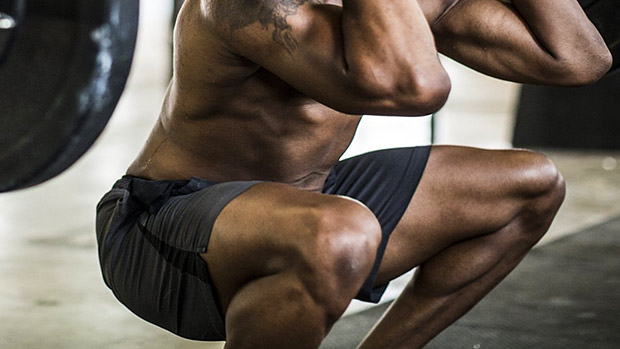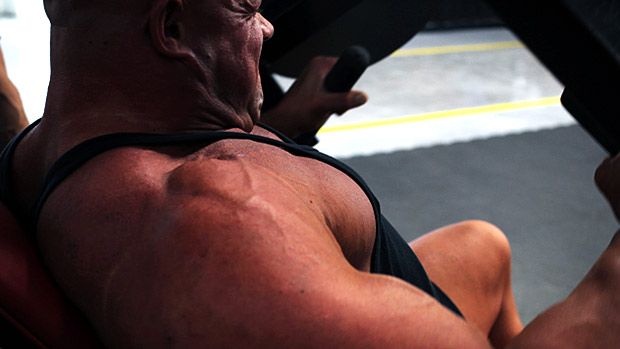Progressive vs. Brogressive
Progressive overload isn't an exciting phrase, but you need to make it a part of your life. Progressive overload is essentially the action of placing more stress and tension on the muscle over time, and increasing this stress over time allows for more strength, growth, and size.
But more often than not, people have a one-dimensional approach to progressive overload. All they ever do is mess with one variable – more weight on the bar! They neglect the other variables (time under tension, decreased rest intervals, changing set/rep ranges, etc.), just for the sake of moving more weight every set.
Here are four reasons why it doesn't always work, followed by four quick fixes to the problem:
We've all seen the guy bouncing on his toes with those 150-pound dumbbells to do what we usually call a shrug, or the kid curling 60-pound dumbbells for one-eighth of the range of motion.
Sure, using heavy weight can help you stimulate some muscle fibers, but damage to these fibers isn't going to happen unless they're under a noticeable amount of tension throughout the entire range of motion.
Look, muscle is expensive for the body to maintain. From a survival standpoint, the body is going to eliminate muscle that isn't being used, or in the case of lifters, muscle that isn't being forced to adapt to resistance. Your body can, and most definitely will, cut and eliminate structural and contractile units (sarcomeres) of your muscle fiber that you aren't using. It's called sarcolysis.
So if you continue to squat, curl, or bench only in one-third of the necessary range of motion, you'd better be sure you're working the full contractile range of that muscle in other exercises.
For example, if your biceps workout consists of doing 50 sets of preacher curls and you only work the top half range of motion (that you're stronger in), your biceps will become shorter and weaker in the bottom range of motion that you're neglecting.
For example, let's say, God forbid, you're the guy half-repping squats... with knee sleeves on. You want to squat deeper, but 405 doesn't look as cool when it pins you to the floor. So instead of decreasing the weight to work that lower range of motion, you stay heavy and just accept your strength gains in that limited range.
Can you still grow? Absolutely! But probably not the way you want. And one day when you DO decide to squat in full-range, you'll be incredibly weak in the hole and super vulnerable to injury (even if it's a dreaded ego injury).
So what are your options here? Squat deeper! Or find another movement to complement your lack of work in that range of motion, like a full-depth hack squat.
The rule is this: Always try to lift heavier, but only as long as you maintain the goal of the exercise!

When I say "angles," I don't just mean angles of motion. I mean angles as in, "considering different ways of approaching the issue." Work the different rep ranges, experiment with shorter rest intervals, push the limits with both heavy AND light weight, change tempos to alter time under tension, and do all of this inside one workout.
For example, if you hit a rack pull for 5x5, make sure you hit a deadlift or posterior chain exercise that works the lower, fully-stretched range of motion too. And since you went heavy with lower reps on that first exercise, maybe you'll do the second exercise using a lighter weight but with a more challenging tempo and range of motion.
For a muscle to adapt, we need to affect as many different fibers inside that muscle as possible. So yes, go heavy! But please, don't let it be the only variable that you think about.
For those who don't know, Elwood Henneman is responsible for the coinage of the term, "The Size Principle." Although he wasn't the first to discover the idea of orderly muscle fiber recruitment, his Size Principle remains relevant and trusted to this very day.
In layman's terms, our body recruits muscle fiber in an orderly and appropriate fashion until the force we produce meets the load placed upon it. The nervous system recruits the smallest, weakest (most fatigue resistant) fibers first and the strongest, largest fibers only when the load is heavy enough to demand it. This is as accurate now as it was then. However, the interpretation and application can get a bit lost in translation.
Most assume we should just lift as heavy as possible and recruit the biggest strongest fibers for growth. That might have been a good strategy when we thought there were only three types of muscle fibers (most people still do). It's much more likely there are far more than simple categories of slow and fast twitch muscle. In fact, the fibers are likely more of a "mosaic" (Pete & Staron, 2000) or gradient, of sorts.
In other words, many fibers fall along some sort of middle ground in between the two categories. While some are undoubtedly purely slow "oxidative" or fast "glycolytic," you need to target the fibers that occupy the middle ground too.
So let's say you start with your heavy sets of 5x3 squats. Sure, you fatigued the biggest, strongest fibers, but you haven't yet tapped into the growth potential of all the other fibers in between. They aren't as innately big in size, but with enough mechanical work you can make these fibers grow, and even shift their behavior and expression as well. Each fiber has a different potential for growth, and if you aren't asking more of those fibers, you may be missing the swole boat.
That's why you need to lift heavy and light, heavy and moderate, and even moderate and light, along with different rep ranges, different tempos, and angles.
1 Work with different rep ranges, but make them all feel heavy.
Do heavy sets of 15 by using perfect form, complete ranges of motion, and no body English or any other form of cheating. So many people get so fixated on the rep range that they forget to make each set a challenging one. Far too many people fall short on this small detail, and their progress stalls out.
2 Mess with the tempo.
Instead of exploding up and just letting the weight fall, take 1, 2, 3, 4, or however many seconds you choose to lower the weight. Incorporate the occasional isometric hold. Much of the untapped mechanical signaling for growth happens in the eccentric (lowering) and isometric portion of the movement. These are the portions of the lift that too many people are skipping for the sake of just getting the rep up.
3 Yes, prioritize your explosive and heavy lifting.
But not at the expense of exploring all ranges of motion.
4 Play with drop-sets, clusters, or breathing sets.
Breathing sets are described in The Breathing Squat Challenge. Like the bodybuilder Tom Platz used to say, if you can find a way to go heavy for high reps, you'll find a lot more muscle growth.





